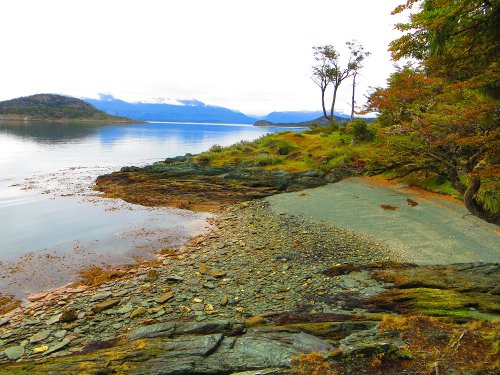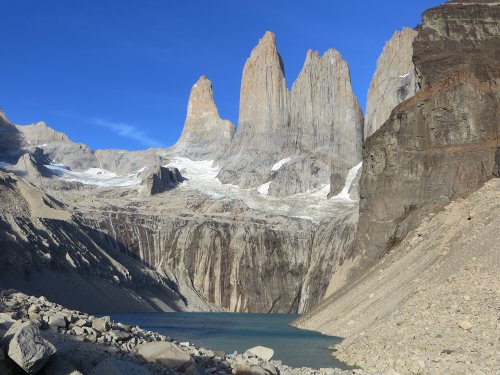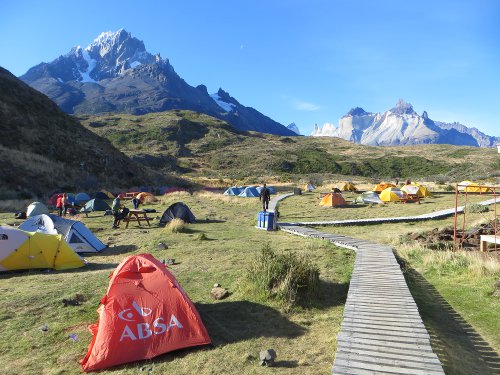Trekking in Patagonia
Patagonia is a spectacular region in our planet which intrigues many to visit and experience it. We were eager and full of expectations to meet her and the reality did not disappoint us. After a month of adventures in the area, we seriously left feeling as we could not wait to be back. We visited a few places and national parks within this extensive region of natural wonders in the countries of Argentina and Chile during the summer season of February 2015. Traveling by bus, we made stops in the cities of Bariloche, El Chalten, El Calafate, Ushuaia, and Puerto Natales from which we ventured to national parks. In all of these places we felt like children in new playgrounds, gladly free to do what we love the most, being one with nature and enjoying days of wilderness backpacking. As an important note for other travelers interested in the planning portion of these Patagonian treks: all of our hikes were planned independently and without the need of a tour guide. We were carrying medium-sized backpacks and only what was truly needed, if you have questions regarding what we took, feel free to ask. We decided not to rent a stove for cooking and took ready to eat food like fresh fruits, bread, crackers, ham, salami, cheese, tuna, olives, pickled vegetables, fruit bars, avocados, tomatoes, mustard, ketchup, chocolate, peanuts, and dried fruits. The cold weather permitted the products like the cheese and deli meats stay fresh regardless of the lack of refrigeration. Our food and gear choices made things a lot easier in terms of weight.
View from Cerro Campanario


From Bariloche, we took three excursions to different day hike destinations all located inside the Nahuel Huapi Naional Park: Cerro Campanario, Parque Municipal Llao Llao, and Cerro Catedral. We hiked up Cerro Campanario in about 20 min and enjoyed the beautiful views of the surrounding lakes and mountains. In the same day, we hiked four hours in the Parque Municipal Llao Llao, where we reached the summit of Cerro Llao Llao which also offers spectacular views. He also found the Hidden Lake and crossed an Arrayan Forest, a magical, native orange-trunk tree with very small green leaves. The next day, we hiked about six hours round trip to reach Refugio Frey. From there, we got amazing views of Cerro Catedral and other close peaks in the surrounding the area.
From El Chalten, we entered into Glaciers National Park – North and completed a 3-day hiking adventure. We spent 2 nights camping in the park carrying our own food and camping gear. Delicious and pure water coming from the glaciers is accessible in different creeks throughout park. We did a loop of about 38 km (23.6 miles). The first day was cloudy and although the famous Fitz Roy was not visible the beautiful park is full of wonders to discover. We set camp for the first night in Poincenot Campground at 8 km (5 miles) from our starting point, and without our pack, we completed a day hike of 4 km roundtrip to Glacier Piedras Blancas. From the top of a giant rock, we witnessed in silence the deep blues and sounds of a talking glacier. The next morning and with the sky wide open, we hiked up a very steep 2 km (1.2 miles) reaching Laguna de los Tres, an idyllic and breath taking view point of Fitz Roy, other peaks, and two gorgeous lakes. In that same day, we packed our tent and trekked passing by Lagunas Madre and Hija until arriving to our second campground at De Agostini. In this campground, we were next to the strong Fitz Roy River and just a few steps away from Laguna Torre. Early morning, the Viewpoint Maestri which is just 2 km (1.2 miles) away from the Laguna Torre, is a perfect place to enjoy the reflection of Cerro Torre over the lake with a huge glacier in the background with pieces of ice melting. On our third and last day, we hiked 9 km (5.6 miles) to return to El Chalten as we gave a farewell goodbye gazing at the amazing views of snowy peaks and glaciers leaving with our hearts broken.
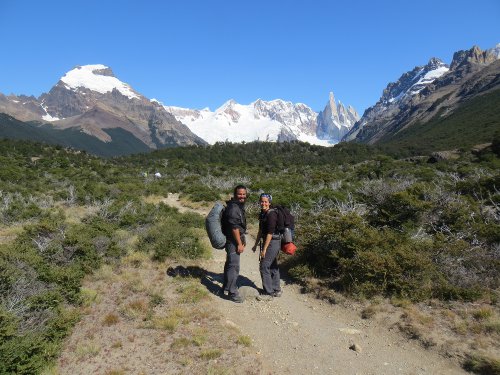
Fitz Roy Mountain Range
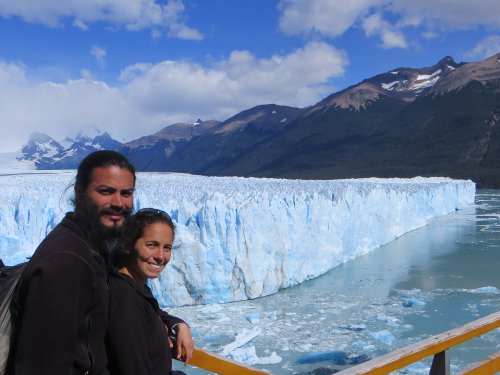
Ice Fall in Perito Moreno Glacier
From the city of El Calafate we traveled by bus to Perito Moreno Glacier. We spent a full day wondering around the 4 km (2.5 miles) of catwalks in the Magellan Peninsula, which offers different viewpoints of this majesty of nature. We honestly did not have many expectations about visiting this glacier, our tendency to doubt massive tourist places made us think: “it will be just like another glacier.” But when we arrived and met Mr. Perito Moreno, up to 55 meters (180 feet) tall, 14 km (8.7 miles) long, and 5 km (3.1 miles) wide, everything changed. We were speechless and infatuated. We could not stop looking at him. We did not want to ever leave him. The strength, shape, and extension of its entire existence was truly love at first sight. The deep echo of its spectacular ice falling was very surprising. The bright white and transparent blue under the sun rays formed all of his peaceful colors of the spectrum. The history behind him and his unstoppable march that is still surviving and going forward in an earth that is getting warmer and warmer, and his resistance to become extinguished like many others of his kind is remarkable. His symbolic 4 year cycle, almost romantic, of forming a bridge that connects him with his eternal companion and witness, the Magellan Peninsula, is magical and simply amazing. More great evidence of how wonderful nature is and how little we are!
We then traveled until “the end of the world” to Ushuaia, Tierra del Fuego and entered into the land where the Yamana, the original people, used to live. We completed a 3-day hike in the National Park Tierra del Fuego which is just 12 km (7.5 miles) away from Ushuaia. We spent two nights camping in the park, carrying our own food and camping gear. We settled and camped the first night at Bahia Ensenada. From there we did a day hike loop of about 10 km (6.2 miles) round trip that took us to a panoramic view, the Rio Pio Waterfall, and back to the campsite. Through the trail we admire the difference in landscape from our previous destinations. The soil was black and moist with beautiful fluffy carpets of moss was everywhere. The vegetation was much greener and at the same time much more fragile. The damage caused by decades of human deforestation as well as the illegal presence of horses coming from neighboring properties into the national park was evident and upsetting. That night was really cold. We used sleeping bags and all of our thermal clothing but still struggled to sleep. While freezing next to each other inside our little tent during a summer night in the end of the world, we thought, with admiration and respect, about the strength of the original native group, the Yamana. The Yamana, before the disruptive appearance of the Anglican missionaries and colonizers, used to live in these lands naked all year long. They had a family nomadic lifestyle within this territory, often moving in search of a better place for fishing and mussel collection by the coast. They would make canoes out of tree bark and while the mother and father fish for food the children will keep a fire going in the center of the boat. They would build and disassemble small shelters to sleep in where the continuous fire was always placed in the center to keep them warm. The Yamana will protect their skin from the cold with animal oils and regardless of the cold conditions and their nudity, they were able to adapt in harmony with the environment. However, the intrusion of the missionaries and their Christian beliefs pushed the Yamana to start wearing clothes, which caused not only the genocide of their culture but the death of most of them. The use of clothes in conjunction with the constant exposure to this humid environment caused the development of hygiene issues that did not exist previously. The damped clothes produced diseases that killed them. The next morning as we walked the 8 km (5 miles) trail along a gorgeous coast of green rocks and calm waters, we felt nostalgia for another form of human life and culture that was exterminated in the hands of colonialism. That day we set the tent in Laguna Verde where we spent our second night, but we continued walking along the area of Lapataia for a least another 4 km (2.5 miles). The day was gloomy and the sun was hidden most of the time but the landscape was beautiful. The bays, lakes, and coast remind us so much of the highlands of Scotland.
On this walk we got to visit active and inactive beaver areas. We were excited to see these animals until we discovered the horrors of their story. Twenty five couples of beavers originally from Canada were introduced into Tierra del Fuego in the 40’s with the intention of fur farming. However, this project, which never met its final goal, created an ecological tragedy. The beavers started building water dams to live as they normally do, but the forest of Tierra del Fuego cannot survive and rebound like the trees of Canada. Huge areas were destroyed and lots of pure water has become contaminated.
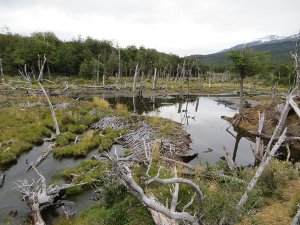
In addition, the lack of predators put the foreign specie in advantage to reproduce which increased the level of their impact in the environment. The park rangers have tried to control the beaver population by hunting some of them, but the damage seems irreversible. Our naive expectations of seeing this “exotic” creature was crushed with the depressing image of the cemeteries they constructed. For us, this was another example of the mistakes and atrocities that can happen as a result of human intrusion in the natural order of the world. At this point we were more than sad about all the negative impact humanity has caused in Tierra del Fuego. Our second night was not as cold as the first one and the weather in the last day of hiking was also better. We walked about 8 km (5 miles) round trip through the Hito trail which bordered Lake Roca reaching the international limit with Chile. We joked and laugh about the possibility of crossing and being “illegal immigrants” while having our legs in two different countries at the same time. On our way back we got to pick and taste Calafate, a native berry of Patagonia that has its very own sour flavor.
We left Tierra del Fuego in the Argentina’s side and entered Chile crossing Magellan’s Strait arriving to Punta Natales. From there, we spent six days trekking in Torres del Paine National Park and completed the famous W route starting at the Park Administration and ending at Laguna Amarga. For the purpose of this multi-day hike we again carried our own food, and camping gear. The first day we hiked five hours from Administration to Paine Grande Camp through a pretty flat and even terrain. The weather was not the best and we had a constant rain sprinkle over us, but arriving at the sky-blue-colored Lake Pehoe brought excitement back into being in the wilderness. We struggled to set camp because of the strong winds and for the first time in our entire world trip we had to tie our tent with cords from all angles to the ground. The sound and shaking of the wind against the tent made it difficult to fall asleep. The next day the weather was a lot better, the view of the Cuernos del Paine (Paine Horns) from the campground was breath taking. We spent a total of 2 nights in Paine Grande camp and on our second day we completed a day hike of 6.5 hours to Grey Glacier Viewpoint. While we were contemplating the Grey Glacier and the pieces of ice floating in the lake, two spectacular condors flew directly over us, so close we thought we were going to have to duck, it was an amazing sensation! On our third day, we hiked from Paine Grande to Italiano Camp for about 2 hours and set tent. Then we hiked a total of 4.5 hours round trip to Britanico Viewpoint passing by Valle del Frances. The day was cloudy and rainy, but the forest was gorgeous and the views from Britanico were still impressive. On our fourth day, we hiked from Italiano Camp to Las Torres Hotel in 6 hours where we set tent and slept that night. We passed waterfalls and rivers and got great views of Lago Nordernskjold along the way which look to us like the Caribbean ocean with small waves of clear blue waters. On the fifth day, we endured a steep hike of 2.5 hours from Las Torres Hotel to Torres Camp and rested the rest of the day for our big finale. The next and final day we woke up early and made our way up to Torres Viewpoint in 45 min. While admiring the view of Las Torres, we felt accomplished and appreciative after six days of trekking. We headed back down to Torres Hotel in about three hours and continued walking towards Laguna Amarga entrance on a very hot day, luckily before we made it there a kind Chilean man picked us up from the road and gave us a ride. Torres del Paine is a treasure of rock formations, lakes, rivers, and glaciers worth visiting. It is not without a reason that this park is one of the top traveling destinations in Chile. On February 28, 2015, we left Torres del Paine National Park saying goodbye and thank you to Patagonia for giving us the chance of feeling fully alive. If you are also a nature lover and have the chance to visit this region of our planet take it without hesitation. 😉


